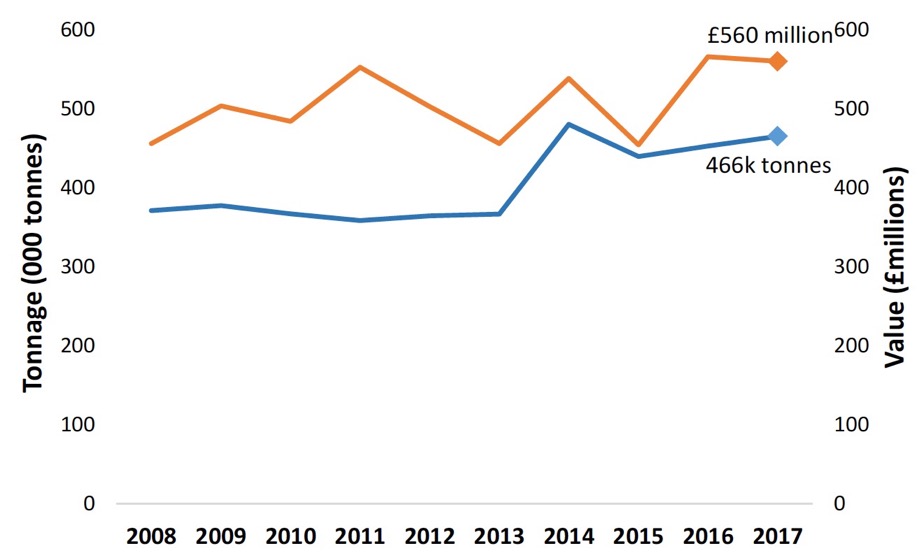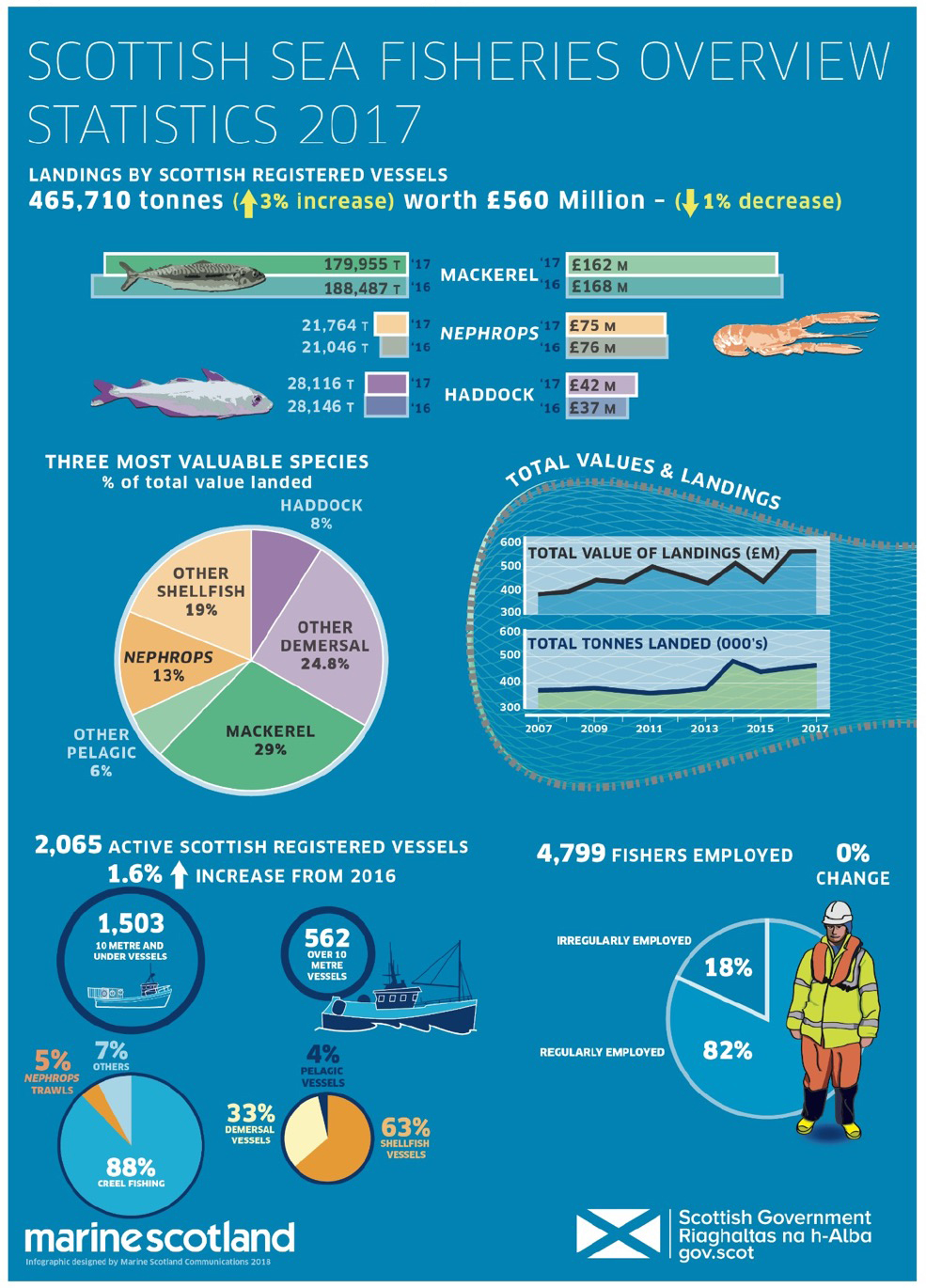Scottish Sea Fisheries Statistics 2017
A National Statistics publication presenting data on the Scottish and UK fishing fleet, landings and employment.
This document is part of a collection
2. Overview Statistics
2.1. Landings by Scottish vessels
In 2017, Scottish vessels landed 466 thousand tonnes of sea fish and shellfish, with a gross value of £560 million. Compared to 2016 there was a small change in the real value of landings (one per cent decrease) and a three per cent increase in the tonnage landed.
The decrease in value was driven mostly by pelagic species – herring and mackerel, as demersal and shellfish species both increased in value. Mackerel remains the most valuable species at £162 million, accounting for 29 per cent of the total value of Scottish landings. In 2017 the real value of mackerel fell six per cent and tonnage decreased by five per cent.
The top three demersal species by value are haddock, monkfish (anglerfish) and cod. The real terms value of haddock was up 11 per cent to £42 million, monkfish three per cent to £36 million and cod 23 per cent to £34 million since 2016. Together these three species account for 20 per cent of the total value of Scottish landings.
Shellfish landings increased in real terms by six per cent to £180 million and the tonnage of shellfish landed decreased by two per cent from 2016. Nephrops are the most valuable shellfish stock and second most valuable stock overall, representing 13 per cent of the total value of Scottish landings in 2017 and 42 per cent of the value of shellfish landings. Scallops are the second most valuable shellfish species landed by Scottish fleet representing seven per cent of the total value and 22 per cent of the shellfish value.
Table 1. Change in total tonnage and value of landings by Scottish vessels between 2017 vs. 2016[1]
| Tonnage 2017 |
Change from 2016 |
Value (£000) 2017 |
Change from 2016 |
||
|---|---|---|---|---|---|
| Demersal |
101,864 |
7% |
183,841 |
7% |
|
| Haddock |
28,116 |
<1% |
42,419 |
11% |
|
| Monkfish |
13,040 |
3% |
36,336 |
3% |
|
| Cod |
14,802 |
3% |
34,295 |
23% |
|
| Pelagic |
301,352 |
2% |
197,088 |
-13% |
|
| Mackerel |
179,955 |
-5% |
161,890 |
-6% |
|
| Herring |
56,423 |
-14% |
23,776 |
-45% |
|
| Shellfish |
62,493 |
-2% |
179,531 |
6% |
|
| Nephrops |
21,764 |
3% |
75,198 |
-4% |
|
| Scallops |
15,772 |
3% |
39,595 |
5% |
|
| TOTAL |
465,710 |
3% |
560,460 |
-1% |
|
Chart 1. Total tonnage and value (adjusted to 2017 prices) of all landings by Scottish vessels, 2008-2017

As shown in Chart 1, the general trend in the tonnage and value of landings over the past ten years is positive; tonnage has increased by 94,000 tonnes (25 per cent) and value in real terms has increased by £104 million (23 per cent) since 2008.
2.2. The Scottish fishing fleet
There were 2,065 active Scottish fishing vessels in 2017, an increase of 32 vessels (two per cent) from 2016. In 2017, the number of over ten metre vessels was 562, down four vessels from 2016. The over ten metre demersal sector consisted of 184 vessels, a decrease of two, while the pelagic sector increased by one to 20 vessels. The number of vessels in the shellfish sector decreased by three to 358 vessels.
There were 1,503 vessels in the ten metre and under fleet, an increase of 39 vessels (three per cent) compared to 2016. Creel fishing dominated the ten metre and under fleet with 1,323 vessels (88 per cent) using this main fishing method.
2.3. Employment
There were 4,799 fishers employed on Scottish based vessels at the end of 2017. This figure is consistent with 2016 (less than one per cent change). Compared to 2016, there were 98 more regularly employed fishers (three per cent increase), 77 fewer irregularly employed fishers (eight per cent decrease) and 45 fewer crofters (88% decrease). This large change in crofters may represent difficulties in accurately identifying crofters.
Figure 1. Overview Statistics – Infographic

Contact
There is a problem
Thanks for your feedback